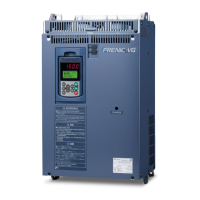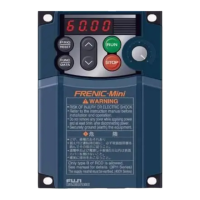6-18
6.2 PG Interface Expansion Card OPC-VG1-PG/PGo
6.2.1 Product overview
The PG interface expansion card is used for speed control using a line driver
output type of encoders, synchronous operation of two or more motors, and
rotational positioning (orientation).
Since the FRENIC-VG's built-in PG interface generates 15 V and 12 V
complementary (totem pole, push-pull) output, the built-in PG interface function
is used when performing speed control with PG feedback using a normal
FRENIC-VG standard motor.
(1) Principal applications
• When interfacing with a PG that is not supported by the built-in PG interface,
for example a 5 V line driver output type PG interface
• When you wish to detect the line speed using a PG installed on the line
• When you wish to drive the motor using pulse train commands or perform
synchronized operation
• When you wish to perform orientation (rotational positioning) (requires a separate UPAC option)
To support applications above individually, the PG interface expansion card has SW1. Switching SW1
selects Speed detection (SD), Line speed detection (LD), Pulse reference (PR) or Pulse detection (PD)
function.
(2) Hardware
Since the interface uses photocoupler insulation, PG wiring may be up to 50 m long with line driver
signals and a small wiring voltage drop.
(3) Broken wire detection function
The broken wire detection function can be used when using SD motor speed detection. When a
broken wire is detected, the inverter will display alarm
p9
, and the interruption of inverter output
will cause the motor to perform a free-run stop. However, this function is not available when using
the open collector/voltage output model (OPC-VG1-PGo). The FRENIC-VG ships with PG broken
wire detection cancelation functionality in its standard configuration.
(4) PG interface expansion card function codes
PG interface expansion card codes (o05 to 08 and o12 to 19) are used for pulse compensation and
other functionality when performing position and line control.
(5) PG frequency division output
As with the built-in PG, when performing speed control with the optional PG set to SD, the FA and
FB built-in terminal blocks can be used to generate open collector output and complementary output
by dividing the pulse signal frequency.
(6) Input format selection
When using the PG interface expansion card to perform speed detection (SD, LD), input signals are
fixed to two signals (A- and B-phase) with a 90° phase difference. When receiving a pulse train
(PR), you can select from three signal types using function codes (o13: pulse train input format
selection).
(7) UPAC function
Cumulative values of PG signal input can be read out from programs running in the UPAC option.
Therefore, the combination of the UPAC option and the PG interface expansion card can build
applications including winding diameter calculation for winders and orientation.

